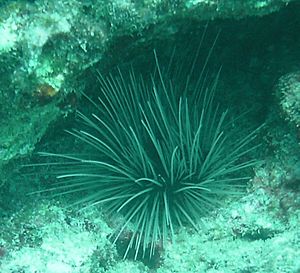Long-spined sea urchin facts for kids
Quick facts for kids Long-spined sea urchin |
|
|---|---|
 |
|
| Scientific classification | |
| Genus: |
Diadema (sea urchin)
|
| Species: |
antillarum
|
| Synonyms | |
|
|

Meet the long-spined sea urchin, also called the lime urchin or black sea urchin. This amazing creature is a type of sea urchin with super long spines. It lives in the Atlantic Ocean and the Caribbean Sea.
These urchins are super important for coral reefs. They are like the gardeners of the reef! They eat algae that can grow too much and harm the corals. When there are enough of these urchins, they help keep the reefs healthy and clean.
Contents
What Makes Them Special?
The long-spined sea urchin has a round body, like a shell. What makes it stand out are its incredibly long spines. Most sea urchins have spines that are only about 1 to 3 centimeters long. But the spines on this species are usually 10 to 12 centimeters long. Some can even grow up to 30 centimeters!
Where They Live and What They Eat
These sea urchins usually live in shallow waters, about 1 to 10 meters deep. You can find them on coral reefs. They often hide in small cracks or holes in the reef. This way, only their long spines stick out, keeping them safe.
If an urchin cannot find a good hiding spot, it will live in more open areas. At night, they often move about one meter from their hiding place to find food. Diadema are very sensitive to light. They often pick their resting spots based on how much shade they can find.
Long-spined sea urchins mostly eat algae. Sometimes they also eat seagrass. If they get very hungry, they might even eat small animals.
Why They Are So Important for Reefs
Diadema antillarum is one of the most common and important sea urchins in shallow tropical waters. You can find them in the tropical Western Atlantic Ocean. This includes the Caribbean Sea, the Gulf of Mexico, and parts of South America. They are also found near the Canary Islands and in the Indian Ocean.
These urchins are super important because they eat algae. If too much algae grows, it can cover and harm the corals. By eating the algae, the urchins help the corals stay healthy and grow. They help keep the entire reef ecosystem balanced.
When Many Urchins Died Off
In 1983, something sad happened. Most of the Diadema antillarum sea urchins in the Caribbean died. More than 97% of them were gone. This was a huge problem for the coral reefs.
Without the urchins eating the algae, the algae grew out of control. This made it hard for new corals to grow. It also made the reefs less able to recover from other problems. This event had a big negative effect on the whole reef.
Luckily, recent studies show that the Diadema are making a comeback in some areas. Places like Discovery Bay, Jamaica, have seen many more urchins. This is helping the reefs start to heal again. The highest increase in urchins has been on the north coast of Jamaica. However, in some places like Florida and Cuba, their numbers are still low.
In 2022, another die-off was reported in some parts of the Caribbean. This shows that these urchins still face challenges.
How Humans Are Helping Them Come Back
When the sea urchins died, the whole coral reef suffered. There was less food and shelter for fish and other animals. This also affected tourism in some countries. Many places depend on their beautiful reefs to attract visitors.
It can be hard for the urchin population to grow back on its own. Predators like fish eat the young urchins. Strong storms can also wash them away. But people are working to help them.
Research and Repopulation Efforts
Scientists are studying how to help Diadema antillarum populations grow. They can grow urchins in labs. Then, these lab-grown urchins can be moved to reefs where there are not many urchins. This helps increase the number of urchins on the reef.
People are also building artificial reefs. These are structures made of materials like concrete. They help new corals grow and provide more places for urchins to hide from predators.
Sometimes, urchins can be moved from reefs where there are many to reefs where there are few. With these methods and the help of volunteers, there is hope. We can help shift the reefs back to being full of healthy corals, instead of being covered in too much algae.
Images for kids


